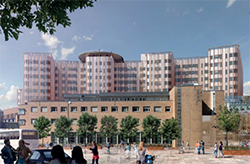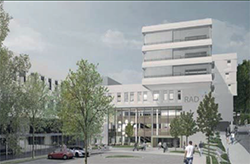-
What the feasibility study may create – A-lab
1. Welcome to Oslo Science City
2. Oslo, Norway and the world during the next decades
3. Why do we need an innovation district?
4. Oslo Science City: Already on track
5. How to finance an innovation district?
6. Gravitational fields of expertise in Oslo Science City
7. Oslo Science City: Sketches, concepts and solutions
9. Knowledge mobilization and the road ahead
4. Already on track
Oslo Science City has already moved far in the direction of developing an innovation district. Oslo Science City is thoroughly anchored to the City of Oslo’s campus strategy which is unanimously adopted by the city council. The membership association Oslo Science City, representing all the key players in the area, is now well established and will ensure that ambitions for the area are realized.
The development of Oslo Science City as an innovation district is already well underway. The City of Oslo’s campus strategy offers a clear strategic framework from the perspective of local authorities. A significant number of major development projects are now being implemented or are in the planning stages. These projects will, both individually and collectively, make important contributions to realizing the objectives for Oslo Science City and provide a concrete platform for further development work.
Oslo Science City is situated in one of the country’s best locations for innovation. With its proximity to some of the strongest universities and research institutes, walking distance from Oslo city center, and a direct connection to 430 km2 of nature areas in Nordmarka, the district is attractive for almost everyone who is interested in innovation, science, the environment and business development. The area is large enough to house Europe’s largest innovation district. It contains land areas that can be developed with both urban and green qualities.
Oslo Science City as a project and as an innovation district is in fact already developing rapidly:
1.
The member association Oslo Science City has been established, with close and formalized collaboration between the largest knowledge and real estate players in the area, the municipality and the start-up ecosystems. Here, the actors pull in the same direction and coordinate important initiatives.
2.
Construction and development projects provide a solid foundation for the future development of Oslo Science City. The feasibility study builds on these projects and includes them in a holistic development of the area.
3.
Several of the actors in the innovation district, including the University of Oslo, are establishing or have established their own master plans for their properties. Plans are linked to the overall strategy for Oslo Science City.
4.
During the last year, students, researchers, business representatives, the municipality, interest groups and the voluntary sector have taken part in the workshops and conferences on the Feasibility Study, providing vital input. In total, 500 participants have discussed needs, solutions and opportunities for Oslo Science City in the future.
5.
Oslo Science City has highlighted four ”gravitational fields” where the existing knowledge base already has obtained, or realistically can develop, internationally leading positions in the future. These gravitational knowledge fields form the very foundation of Oslo Science City. They will form the innovation district’s profile and identity, nationally as well as internationally
Running projects and important plans
Here we present a list of projects that are either up and running or have progressed far into the planning stages. The ground has been cleared for investment projects amounting to approximately NOK 15 billion. 200,000 m2 are made available for knowledge actors in these areas. Investment plans amount to NOK 35 billion, totalling 400,000 m2 of specialized knowledge buildings for Oslo Science City, as well as residential and commercial areas. At the time of writing, the list of planned and ongoing development projects in Oslo Science consists of 14 initiatives. UIO AND
OUS: LIFE SCIENCE BUILDING
When completed, the Life Science Building will be Norway’s largest (100,000 m2) and most modern building for interdisciplinary research and teaching. The building will house large parts of the academic communities for life science at the University of Oslo (UiO) and the Division of Laboratory Medicine (KLM) at Oslo University Hospital (OUS). The building will be designed for extensive cooperation with external actors and cooperation partners. Expected completion by the end of 2026.
NGI: CAMPUS ULLEVÅL
NGI plans to build a new research and business campus (30,000 m2) on its current property. The building will be a model for environmentally friendly technical solutions and constitute the northeastern entrance to Oslo Science City. Expected completion in 2025. The Norwegian Geotechnical Institute (NGI), the Norwegian Institute for Energy Technology (IFE), the Norwegian Institute for Water Research (NIVA) and the Norwegian Institute for Air Research (NILU) have entered into a strategic cooperation on research and innovation. The four institutes plan to be physically present on the new Campus Ullevål and are collaborating to establish this as a campus and a powerhouse for research and innovation within climate, energy and the environment.
OSLO UNIVERSITY HOSPITAL: RIKSHOSPITALET
This project is planned with a large (140,000 m2), new and future-oriented stock of buildings for Oslo University Hospital. It will unite regional and national functions, and at the same time serve as a local hospital for 200,000 inhabitants of Oslo. The development will house highly specialized functions within patient care, research and education. Expected completion in 2030.
NEW BUILDINGS AT RADIUMHOSPITALET
Oslo University Hospital will develop Nye Radiumhospitalet further as a specialized cancer hospital with a new clinic building and a proton treatment unit. Expected completion in 2023. SINTEF SINTEF plans to expand its existing offices and laboratories in Gaustadbekkdalen with 21,300 m2. A new building of 11,000 m2 is planned at MiNaLab (microand nanotechnology). OSLO SCIENCE PARK Oslo Science Park will be expanded so it can house more start-ups and high growth companies for a longer period of time. The expansion of 22,000 m2 will take place through several stages and bring Oslo Science Park to a total size of 78,000 m2. The first major milestone is a new 12-storey building above the entrance square with expected completion in 2024. NEW CLINIC BUILDING FOR ODONTOLOGY The University of Oslo is planning a new clinic building for dentistry/odontology on the site of today’s Nemko-building. Four clinics and the Dental Health Service’s Competence Center East will be located here. The project is awaiting approval for start-up of a preliminary stage.
OSLO CANCER CLUSTER
Oslo Cancer Cluster is planning to expand the existing innovation park with 7000 m2. In addition, Oslo Cancer Cluster is in discussions with neighbouring landowners about a further expansion of 40,000-50,000 m2. The expansion is expected to be completed in 2023.
NEDRE BLINDERN
More than 20,000 m2 will be freed up in the Nedre Blindern area when institutes for pharmacy and chemistry move into the new Life Science Building in 2024. There are also some opportunities for densification on Campus Blindern to meet future space needs of the University of Oslo.
FERD: MARIENLYST-PROJECT
The former site of the Norwegian Broadcasting Corporation (NRK) of 85 acres at Marienlyst will be developed into a new and inclusive area with 1200 new homes, jobs, sports and culture. Ferd plans to create meeting arenas between students, sports, children, young people, culture and the innovation ecosystems in the surrounding area. Marienlyst will be a cooperation partner for Oslo Science City, but the area will be developed on its own terms, with its own vision and objectives. Marienlyst will also be an area for recreation and socializing, and a variety of high quality homes and commercial premises will be developed.
RUTER: TRANSFORMATION OF MAJORSTUEN METRO AND TRACK AREA
Norway’s third largest public transport hub will be upgraded, connected to the Fornebu rail line and placed underground. This will free 100,000 m2 for sustainable urban and commercial development. The area has been proposed as a “Gateway to Oslo Science City”. Expected completion 2027.
NEW STUDENT HOUSING
The Foundation for Student Life (SiO) has built new student housing in Blindernveien. The world’s tallest solid wood building contains 290 units of new student housing. There is also a new cafe, a youth club and a student kindergarten with four units connected to the building. The first housing units were opened in May 2021. KNOWLEDGE STREET Kunnskapsgaten Blindernveien UiO is working on a concept for the development of Blindernveien as a knowledge street. This type of development will enable the co-location of university functions and knowledgeintensive businesses. The Knowledge Street will mirror the overall ambition of Oslo Science City and help create meeting places for knowledge sharing. Status: Feasibility study completed.
SOGNSVEIEN 80-90
The area around Blindern upper secondary school will be developed into a diverse neighbourhood, which may function as a showcase and a learning arena for future-oriented, sustainable urban development. The project will include a school, nursing home, sports facilities and a kindergarden, and provide opportunities for the development of residential housing and knowledge-based business and industry.
Involve, engage and find opportunities
The process of this feasibility study has shown that there is strong interest and commitment among the people who will create, live, study and work in Oslo Science City. Through a broadbased participation process in 2020 and 2021, a total of 500 researchers and employees, neighbours, students, business representatives, entrepreneurs, growth companies, top executives and politicians have been involved in a series of workshops and interviews.
As many as 18 workshops and a long series of conversations have been conducted during this period. Life sciences, digitalization, democratic development, inclusion, climate, energy and sustai - nability were subjects in the center of discussion. The workshops have also considered business development, urban development, investments and competence requirements. All participants have developed a more detailed understanding of what it will take for Oslo Science City to become a world-leading innovation district.
How did the participants experience these workshops? Have they strengthened their idea of Oslo Science City as an engine for innovation and value creation in Norway in the time to come? We have presented them with three statements on the topic. A total of 95 participants have told us what they think:
“Oslo Science City will increase the ability of Oslo and Norway to create value in the coming decades.”
Oslo Science City will increase the ability of Oslo and Norway to create value in the coming decades
By connecting knowledge, the business community and the public sector more closely, Oslo Science City will contribute to increased capacity to innovate
Workshops have given me stronger insight and more motivation to help realize the ambitions for Oslo Science City















